Need to notify all available agents when an incoming call comes into your contact center? Use Simultaneous Ring to make sure calls are answered quickly and efficiently.
Simultaneous Ring helps reduce caller wait times, improve answer rates, and promote more efficient and positive customer interactions.
Let’s dive into the details.
EAP Feature
Simultaneous Ring is currently in an Early Adopter Program and is not yet available to all users.
Who can use this
Office and Company Admins can create Simultaneous Ring Contact Centers.
Create a Simultaneous Ring Contact Center
To create a simultaneous ring contact center, go to your Dialpad Admin Settings.
Navigate to Contact Centers
Select the + icon
If you’re an Office Admin, you’ll also see a Create Contact Center button
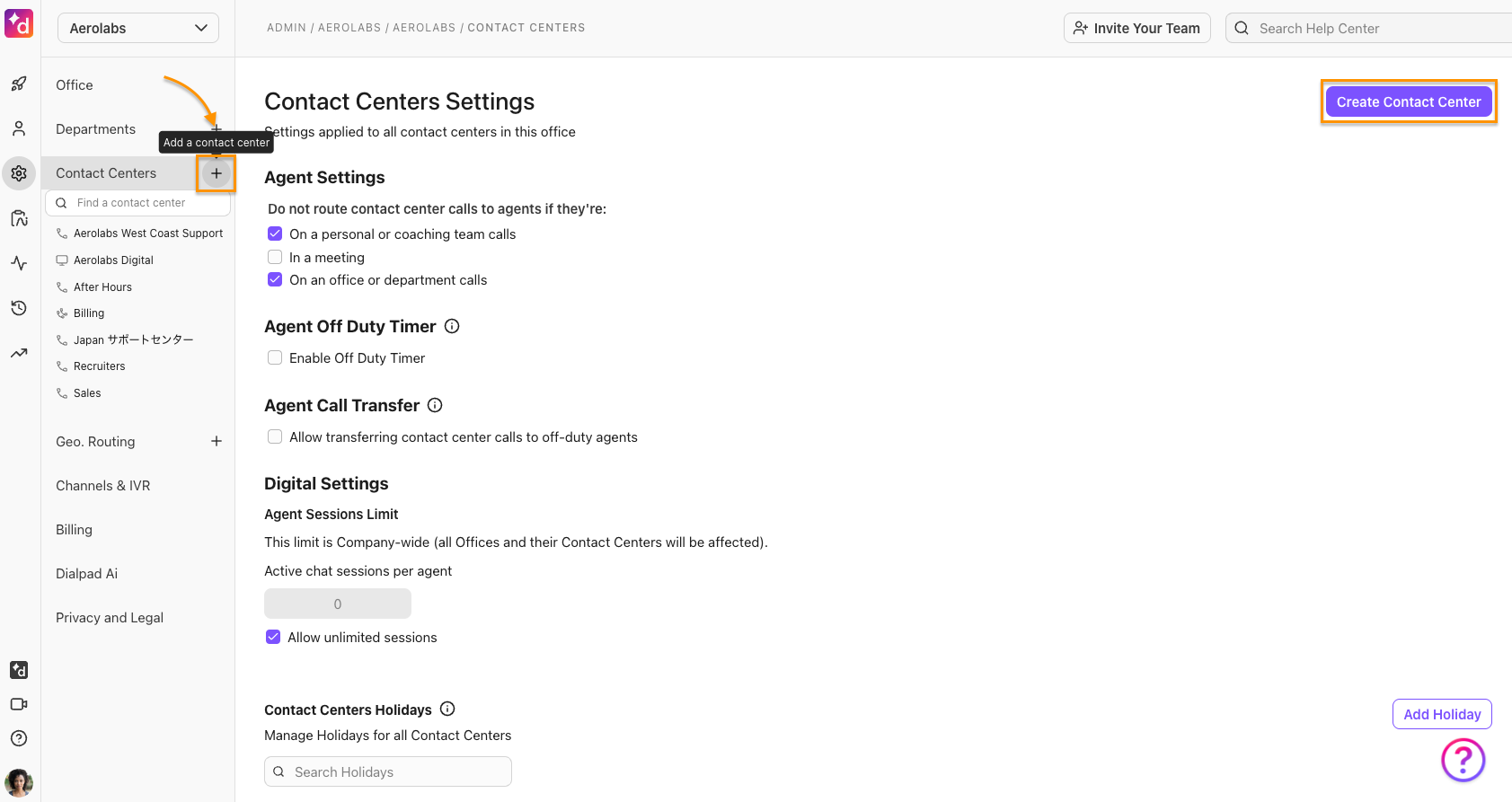
Select Voice > Ring all agents at once
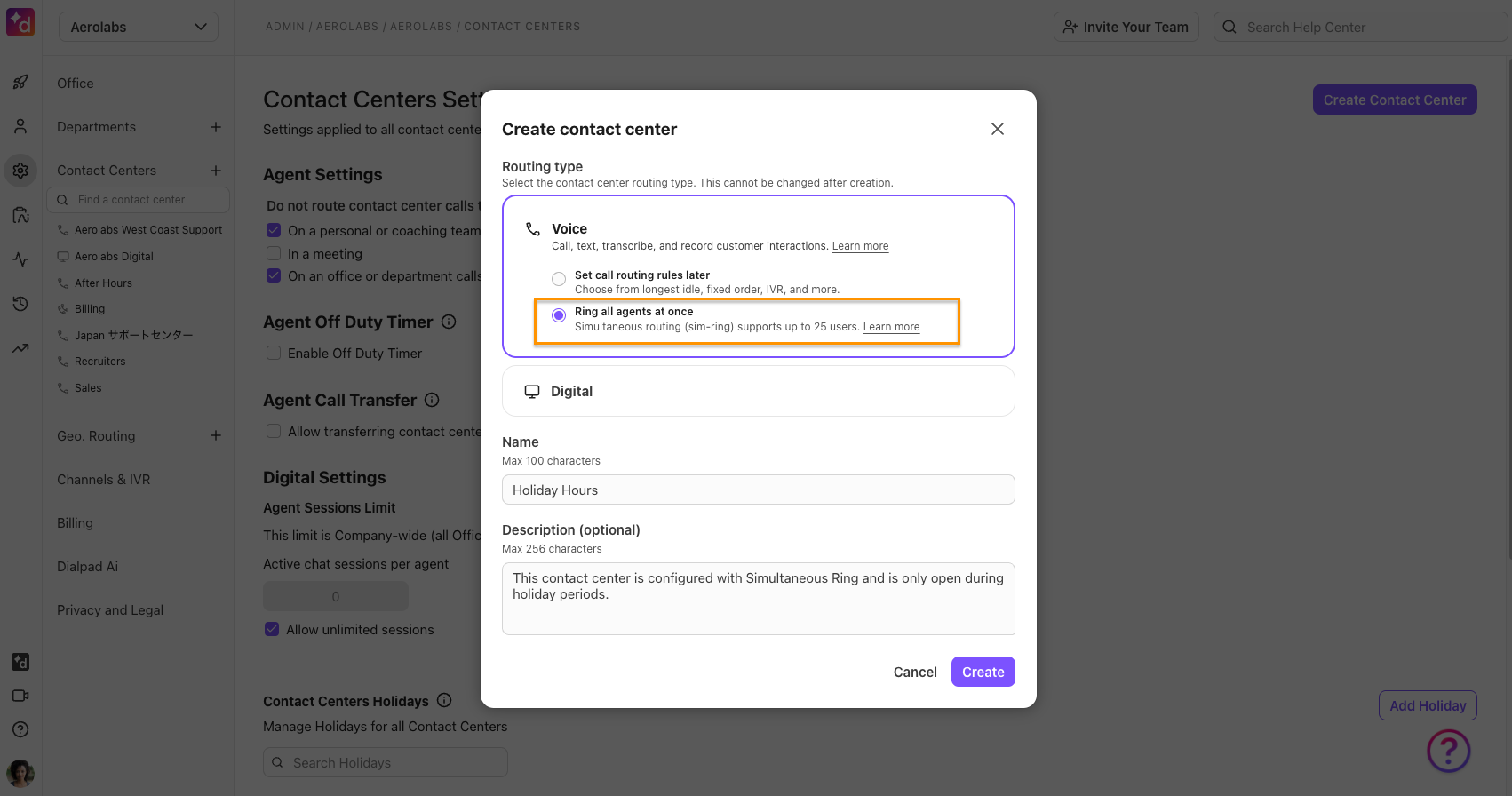
Name the contact center
Add a description (optional)
Select Create
Next, it’s time to give your contact center a phone number.
On the Contact Center page:
Select Add a number
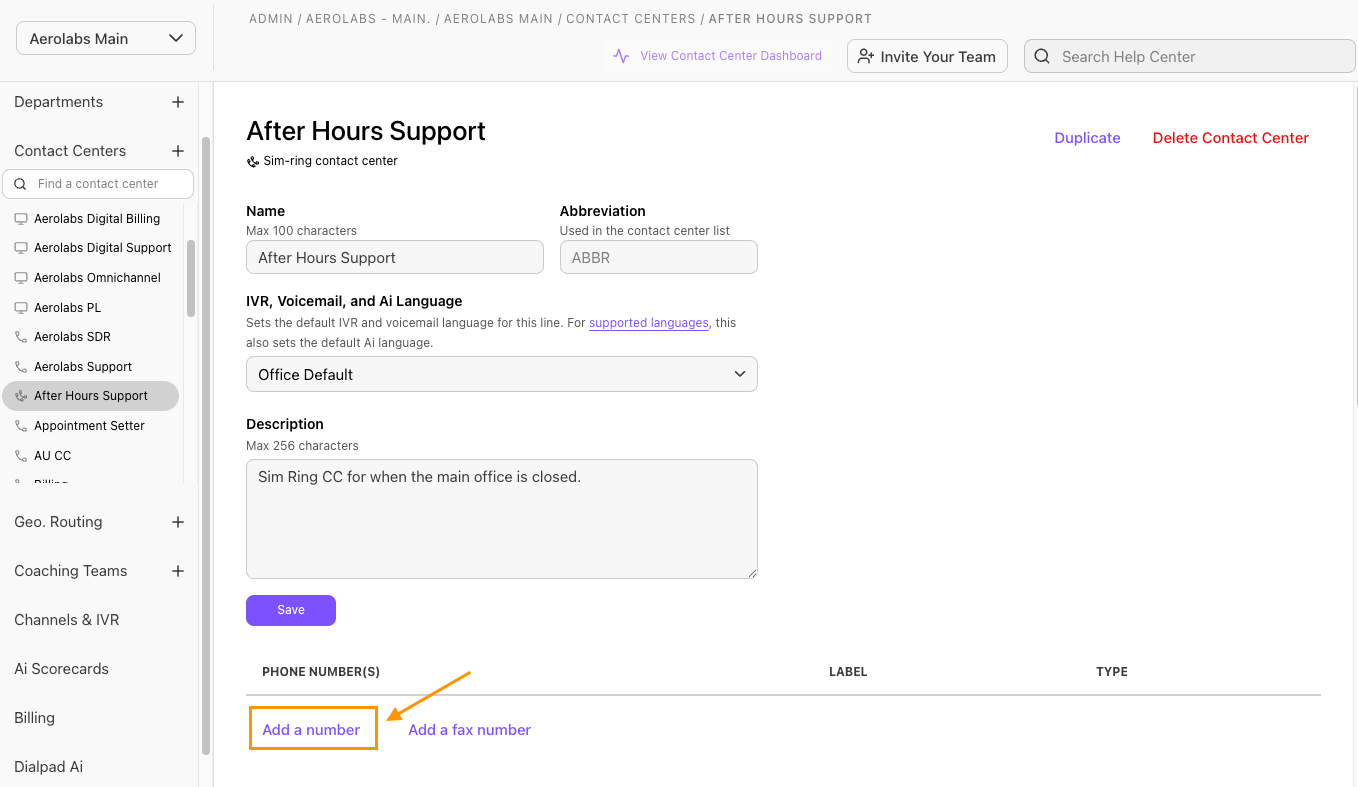
Choose the number type > select Confirm
Add agents to a Simultaneous Ring Contact Center
The maximum number of users allowed in a Simultaneous Ring Contact Center is 25 (agents and supervisors).
To add agents to a Simultaneous Ring Contact Center, go to the contact center’s settings.
Select Agents and admins
Enter the agent name(s) in the search bar
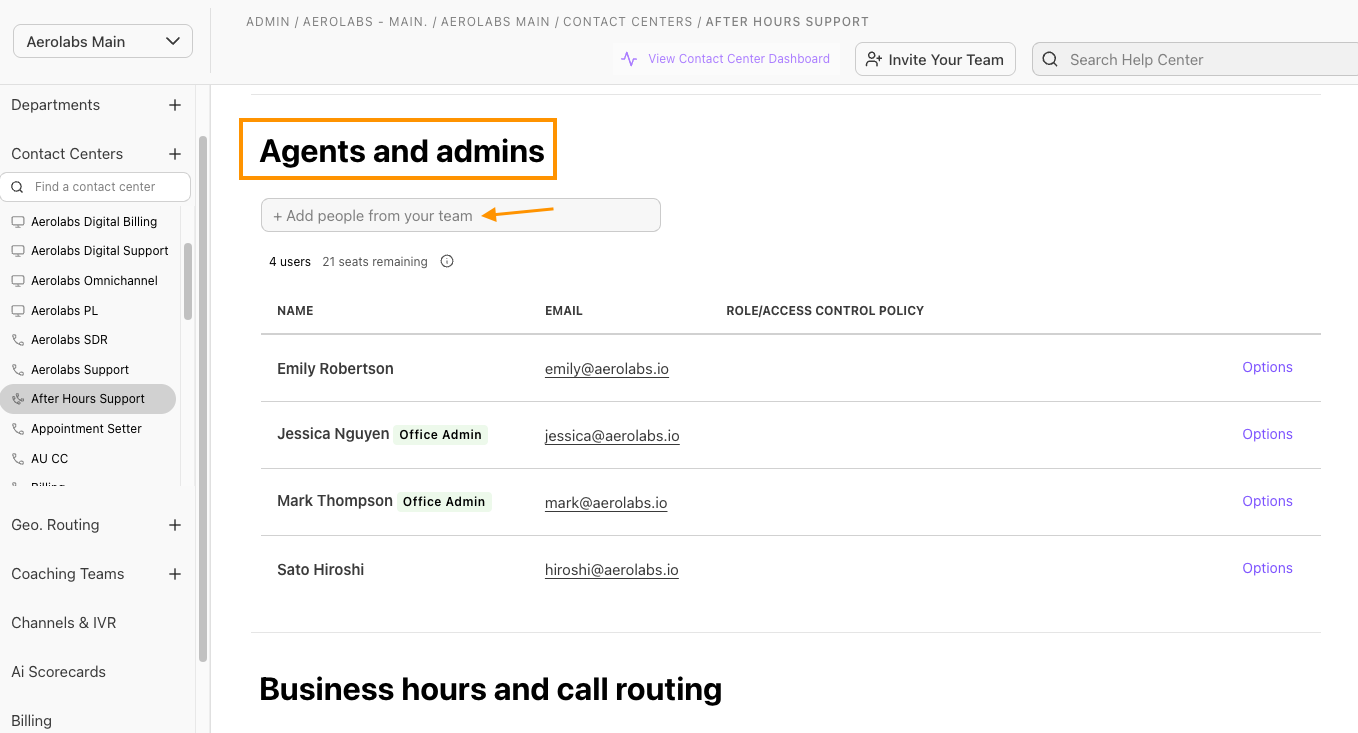
Note
When the 25 user limit is reached, you must remove a user before adding another.
Call routing for Simultaneous Ring Contact Centers
Once a Simultaneous Ring Contact Center is created, its agent routing type is fixed to simultaneous ringing and cannot be changed.
However, other routing options are provided to redirect calls within the queue.
To configure other routing options for a Simultaneous Ring Contact Center, go to the contact center’s settings.
Select Business hours and call routing
Select Edit Call Routing
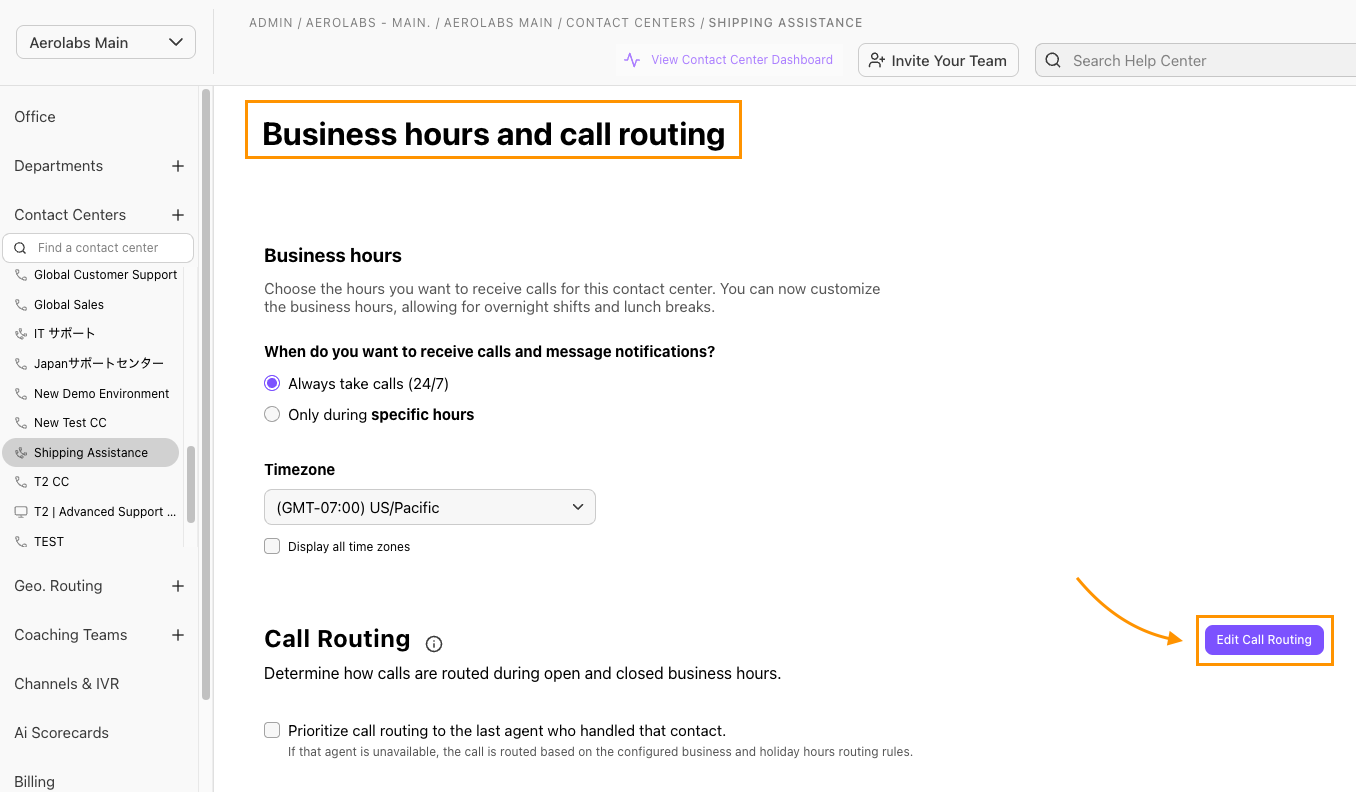
Select Other Routing Options
Other Routing Options offers the following choices:
Directly to voicemail | Routes callers direction to voicemail. Agents receive notifications when voicemails are left. |
To a message (no voicemail) | Routes callers to a default or custom message. There is no option to leave a voicemail. |
To another department, office, contact center, or geo router | Routes callers to a different shared line. |
To a team member/room phone/number | Routes callers to a specific number. To route to a non-Dialpad number, contact our Customer Care Team. |
To an automated response menu | Routes callers to a menu. Options include dial by name directory (Office), dial by extension directory, dial by name directory (Company), forward to a Department/Contact Center/Office, forward to a person or number, leave a voicemail, recorded message, operator, and disabled. If you forward to another Department or Contact Center using an automated response menu, you can choose one that is located in another office within the entire company.
|
To an IVR workflow | Route calls through a customized IVR system. Learn more about IVR workflows in this Help Center article. |
Callbacks in a Simultaneous Ring Contact Center
When a contact center is configured with Simultaneous Ring, the “Call Agent First” setting for callbacks is always turned on by default—and cannot be turned off.
In Simultaneous Ring queues, agents do not enter an RNA (Ring No Answer) state if they miss a call. This makes it difficult to accurately determine whether an agent is truly available.
Callback functionality can still be enabled or disabled in your queue settings—but when enabled, “Call Agent First” will always be enforced in Simultaneous Ring setups.
Callbacks do not support ringing all agents simultaneously. It will ring to one agent at a time until an agent answers the call or it times out.
Frequently asked questions
Why can’t I turn on Auto Answer for this contact center?
Auto answer is not available with Simultaneous Ring contact centers.
Why can't I change the 'Allow agents to miss calls' number?
In a Simultaneous Ring contact center, the 'Allow agents to miss calls' setting is fixed to infinity and cannot be modified. This configuration prevents agents from being automatically set to an unavailable status when they miss a call.
Why do callers hear hold music instead of ringing in Simultaneous Ring contact centers?
Unlike standard contact centers, where callers hear ringing first, Simultaneous Ring starts hold music immediately. This is intentional and helps create a consistent caller experience.
What happens when an agent misses a call?
In a Simultaneous Ring Contact Center, if an agent does not answer the call, they will not be placed into an Ring No Answer State.
What happens when an agent rejects a call?
In a Simultaneous Ring Contact Center, if an agent rejects a call, the agent will remain available but is removed from the pool of available agents for that call. The remaining available agents will continue to ring for that call until it is answered or times out.
If an agent finishes a call while another is waiting, when are they offered the waiting call?
If Agent A is on a call and a new call arrives, the new call rings all other available agents.
If Agent A ends their call and becomes available before the new call is answered, then Agent A is added to the next ring group for that call, but the call is not assigned to Agent A while it's in the queue.
If the new call is currently ringing to available agents when Agent A becomes available, then Agent A remains available until that ring group times out. If no agent answers, Agent A is added to the next ring group.
If an agent rejects a simultaneous ringing call and becomes available does that prevent them from being presented other contact center calls waiting in queue?
No. The agent will be presented another contact center call if there is a call waiting in queue of another contact center they are a member.
If agents miss the first round of ringing and then go back into an available state, can they be presented with different call?
Yes, there is a possibility the agents could be presented with a different call from another contact center the agents are a member.
Can I use prioritized call routing with Simultaneous Ring?
Yes. If Prioritize call routing to the last agent who handled that contact is turned on, calls go to the last agent who spoke with the customer first. If they don’t answer, the call returns to the queue briefly, then rings the other available agents in the Simultaneous Ring group.
How can I share my feedback?
A huge part of the EAP process is getting your feedback on what’s working and what needs more attention before publicly launching the feature.
Please contact our Customer Care team (or your Customer Success Manager) to provide us with your thoughts.
Please note that we may use your responses in marketing promotions for the product launch (don’t worry, we will ask for approval before doing so).